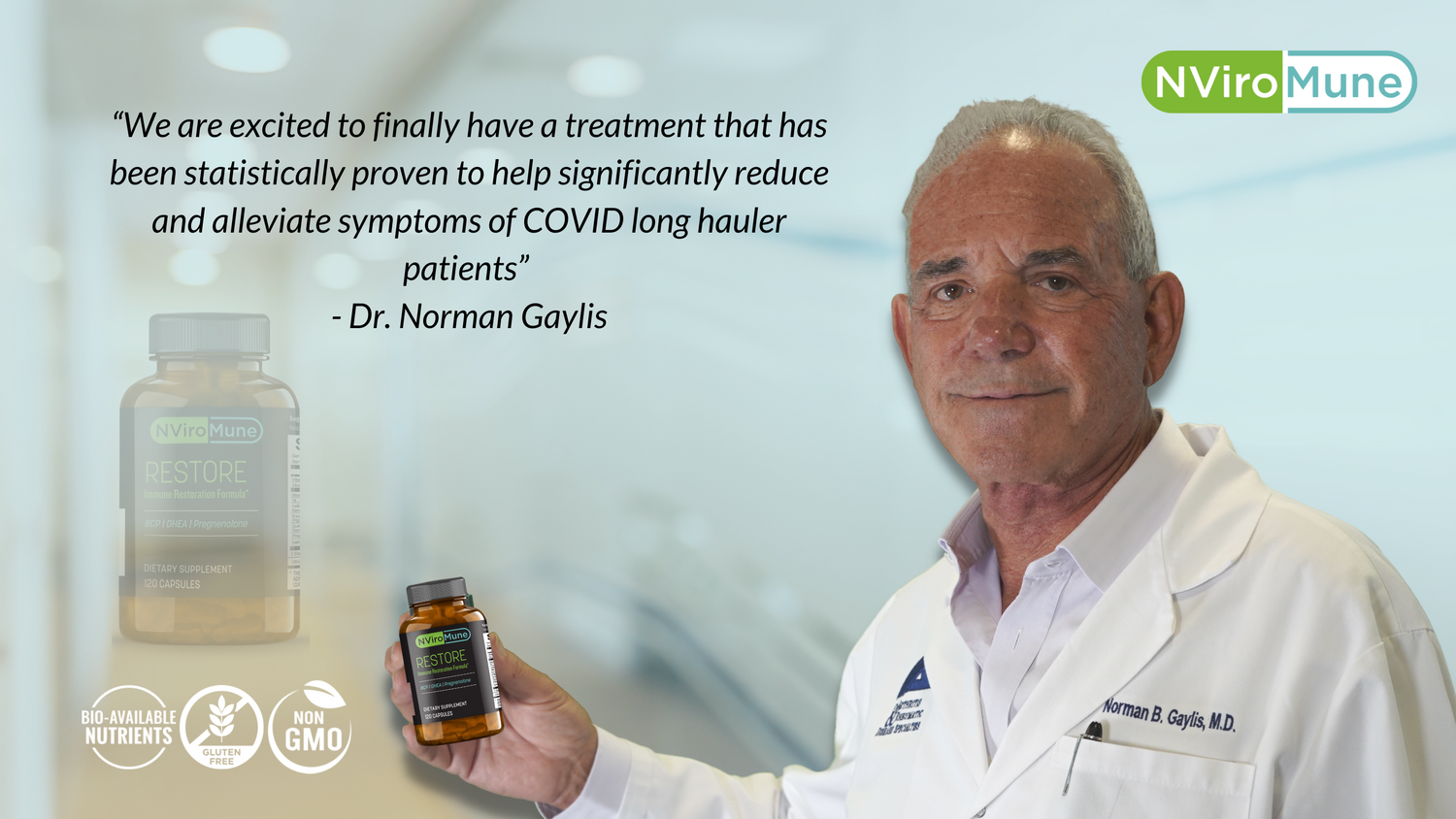ABOUT RESTORE
Long-Hauler Support Formula
proven by clinical study to improve symptoms
of covid long-haulers
* statistically significant improvement in just 4 weeks.
*FOR ADULTS. NOT WHILE PREGNANT AND BREASTFEEDING

Long-Hauler Support Formula
proven by clinical study to improve symptoms
of covid long-haulers
* statistically significant improvement in just 4 weeks.
*FOR ADULTS. NOT WHILE PREGNANT AND BREASTFEEDING
By combining the support of 9 nutraceuticals, RESTORE works to combat and
to improve all different symptoms of long-haulers.

Discover what our researchers have to say about RESTORE by clicking the play button.

 "Thanks a million. I can see a real difference when I took it! Can't
wait for it to go onto the market! Hugs :)"
"Thanks a million. I can see a real difference when I took it! Can't
wait for it to go onto the market! Hugs :)"  "2 years of symptoms, pain and dysfunction, are resolving. Most of my
pain is gone, energy level greatly improved and fog reduced"
"2 years of symptoms, pain and dysfunction, are resolving. Most of my
pain is gone, energy level greatly improved and fog reduced"  "I've seen a decrease of hair loss while using these nutraceuticals.
Slight improvement of smell and taste in the last two weeks but that's
been sort of consistent with my recovery since covid. Smell and taste
still is distorted and very limited."
"I've seen a decrease of hair loss while using these nutraceuticals.
Slight improvement of smell and taste in the last two weeks but that's
been sort of consistent with my recovery since covid. Smell and taste
still is distorted and very limited."  "I have to say I felt better while I was on the trial. Right now it's
not super bad but I truly think he would help me a lot to have more
pills. However, I have to say, I think these pills are a game changer,
they build up on you and make the pain easier to cope with; It's like
you feel the pain but never to the degree or intensity of before."
"I have to say I felt better while I was on the trial. Right now it's
not super bad but I truly think he would help me a lot to have more
pills. However, I have to say, I think these pills are a game changer,
they build up on you and make the pain easier to cope with; It's like
you feel the pain but never to the degree or intensity of before." 
"I'm almost nine months into this nightmare that I'm living. I've seen 40 doctors, I've been to the ER five times, I've been hospitalized twice, and I still don't have answers." Abby Gresko Barclay has had coronavirus symptoms for nine months.
In some patients the
effect of covid linger after the infection is no longer active.
These patients suffering from lingering symptoms of the virus are
called long-haulers. They have in theory recovered from the worst
impacts of covid and some may have tested negative for the
antibodies; however, they are still symptomatic. They may have
lingering symptoms or have developed new complaints which range from
mild to debilitating. The most common long-haulers symptoms include:
RESTOREsignificant improvement in 4 weeks in many of the symptoms.

High-quality, unprocessed
natural
material

World-renowned doctors and scientists

GRAS-Approved supplements

Patented formula
Common Questions
By purchasing our product, we would like to create a long-lasting relationship between NViroMune and you. We are here to answer any questions about our product or company. If you don't find the answer you need here, please feel free to call our customer service number at (888) 776-8660
2-6 weeks.
In our study we found brain fog, GI symptoms, joint pain, and fatigue improved the most but everyone is different.
In our study we found brain fog, GI symptoms, joint pain, and fatigue improved the most but everyone is different.
2 capsules two times daily.
β-Caryophyllene, A Natural Dietary CB2 Receptor Selective Cannabinoid can be a Candidate to Target the Trinity of Infection, Immunity, and Inflammation in COVID-19:
Based on its pharmacological properties, molecular mechanisms, and the therapeutic potential of BCP as an immunomodulator, anti-inflammatory, organ-protective, and antiviral, we hypothesize that BCP could be a promising therapeutic and/or preventive candidate to target the triad of infection, immunity, and inflammation in COVID-19.
A focused review on CB2 receptor-selective pharmacological properties and therapeutic potential of β-caryophyllene, a dietary cannabinoid:
The focus of the present manuscript is to represent the CB2R selective agonist mediated pharmacological mechanisms and therapeutic potential of BCP.
β-Caryophyllene: A Sesquiterpene with Countless Biological Properties:
β-Caryophyllene (BCP), a natural bicyclic sesquiterpene, is a selective phytocannabinoid agonist of type 2 receptors (CB2-R). It isn’t psychogenic due to the absence of an affinity to cannabinoid receptor type 1 (CB1).
Protective Effects of (E)-β-Caryophyllene (BCP) in Chronic Inflammation:
(E)-β-caryophyllene (BCP) is a bicyclic sesquiterpene widely distributed in the plant kingdom, where it contributes a unique aroma to essential oils and has a pivotal role in the survival and evolution of higher plants
Dehydroepiandrosterone decreases mortality rate and improves cellular immune function during polymicrobial sepsis:
Conclusions: These results demonstrate that DHEA administration leads to an increased survival following a septic challenge. The immunoenhancing effect of DHEA is accompanied by a reduction of TNF-a release and an improved activity of T-cellular immunity. DHEA administration may, therefore, be beneficial in systemic inflammation.
Dehydroepiandrosterone (DHEA) restrains intestinal inflammation by rendering leukocytes hyporesponsive and balancing colitogenic inflammatory responses:
Dehydroepiandrosterone (DHEA) is a hormone that plays an important role in the modulation of inflammatory responses.
Replacement therapy with DHEA plus corticosteroids in patients with chronic inflammatory diseases--substitutes of adrenal and sex hormones:
These studies clearly indicate that chronic inflammation alters, particularly, the adrenal response. However, at this point, the reason for the specific alteration of adrenal function in relation to pituitary function remains to be determined.
Female reproductive hormones may be protective against COVID-19:
Both allopregnanolone and its precursor pregnenolone blocked the entire TLR4 signaling pathway. Both molecules inhibited the binding of TLR4 to myeloid differentiation factor 2 (MD-2) in macrophages and the myeloid differentiation primary response 88 (MYD88) in the brain.
The neurosteroid pregnenolone promotes degradation of key proteins in the innate immune signaling to suppress inflammation:
Here we report that pregnenolone promotes ubiquitination and degradation of the TLR2/4 adaptor protein TIRAP and TLR2 in macrophages and microglial cells. Pregnenolone and its metabolites suppressed the secretion of tumor necrosis factor α and interleukin-6 mediated through TLR2 and TLR4 signaling.
Review Article Open Access
The Role of Pregnenolone in Inflammatory Degenerative Brain Disease:
Pregnenolone-sulphate show an interesting antinflammatory propertie, and, secreted locally into the brain by microglia cells, may play a promising role in neurodegenerative disease.
Neurosteroids as regulators of neuroinflammation:
Several functions of the central nervous system (CNS) are influenced by steroid hormones (Compagnone and Mellon, 2000, Mellon and Griffin, 2002). Circulating steroids produced by the adrenal glands, the gonads and the placenta readily cross the blood brain barrier (BBB) and reach their target cells in the CNS by diffusion; these are termed ‘neuroactive’ steroids (Mellon and Griffin, 2002, Schumacher et al., 2003, Starka et al., 2015).
Effect of Pregnenolone vs Placebo on Self-reported Chronic Low Back Pain Among US Military Veterans:
The use of pregnenolone in this randomized, double-blind, placebo-controlled clinical trial in 94 veterans with chronic low back pain resulted in a significant reduction in pain intensity ratings after 4 weeks of treatment.
Zn2+ Inhibits Coronavirus and Arterivirus RNA Polymerase Activity In Vitro and Zinc Ionophores Block the Replication of These Viruses in Cell Culture:
Increasing the intracellular Zn2+ concentration with zinc-ionophores like pyrithione (PT) can efficiently impair the replication of a variety of RNA viruses, including poliovirus and influenza virus.
Clinical significance summary: Preliminary results of a rapid review of zinc for the prevention and treatment of SARS-CoV-2 and other acute viral respiratory infections:
As of 9 June 2020, indirect evidence from other types of viral respiratory infections suggests that zinc may potentially reduce the risk, duration and severity of SARS-CoV-2 infections; particularly for populations at risk of zinc deficiency.
Zinc for the prevention and treatment of SARS-CoV-2 and other acute viral respiratory infections: a rapid review:
Currently, indirect evidence suggests zinc may potentially reduce the risk, duration and severity of SARS-CoV-2 infections, particularly for populations at risk of zinc deficiency including people with chronic disease co-morbidities and older adults.
The Potential Impact of Zinc Supplementation on COVID-19 Pathogenesis:
As zinc is essential to preserve natural tissue barriers such as the respiratory epithelium, preventing pathogen entry, for a balanced function of the immune system and the redox system, zinc deficiency can probably be added to the factors predisposing individuals to infection and detrimental progression of COVID-19.
A Hypothesis for the Possible Role of Zinc in the Immunological Pathways Related to COVID-19 Infection:
20-Week Study of Clinical Outcomes of Over-the-Counter COVID-19 Prophylaxis and Treatment:
The Role of Zinc in Antiviral Immunity:
Few studies have examined the antiviral effects of zinc on other respiratory viruses. In vitro replication of influenza (PR/8/34) is significantly inhibited by the addition of the zinc ionophore pyrrolidine dithiocarbamate (110), perhaps through inhibition of the RNA-dependent RNA polymerase (RdRp), as had been suggested 30 y earlier (111)
Anti-inflammatory potential of Quercetin in COVID-19 treatment:
SARS-CoV-2 is a betacoronavirus causing severe inflammatory pneumonia, so that excessive inflammation is considered a risk factor for the disease. According to reports, cytokine storm is strongly responsible for death in such patients.
Quercetin: New Hype for COVID-19?
Quercetin has long been evaluated for its potential protective effects against cancers, heart disease, and cells that release histamines.
Quercetin as a potential treatment for COVID-19-induced acute kidney injury: Based on network pharmacology and molecular docking study
Kidneys are one of the targets for SARS-CoV-2, it is reported that up to 36% of patients with SARS-CoV-2 infection would develop into acute kidney injury (AKI). AKI is associated with high mortality in the clinical setting and contributes to the transition of AKI to chronic kidney disease (CKD)
Quercetin: Antiviral Significance and Possible COVID-19 Integrative Considerations:
Quercetin, a naturally occurring dietary flavonoid, is well known to ameliorate chronic diseases and aging processes in humans, and its antiviral properties have been investigated in numerous studies. In silico and in vitro studies demonstrated that quercetin can interfere with various stages of the coronavirus entry and replication cycle such as PLpro, 3CLpro, and NTPase/helicase.
Quercetin, Inflammation and Immunity:
In vitro and some animal models have shown that quercetin, a polyphenol derived from plants, has a wide range of biological actions including anti-carcinogenic, anti-inflammatory and antiviral activities; as well as attenuating lipid peroxidation, platelet aggregation and capillary permeability.
Bromelain inhibits SARS-CoV-2 infection via targeting ACE-2, TMPRSS2, and spike protein:
Recently, studies have shown that SARS-CoV-2 homotrimeric viral spike protein (S1) binds to the Transmembrane Serine Protease 2 (TMPRSS2) primed host cell's receptor ACE-2 for initial entry, followed by S2-mediated membrane fusion.
Bromelain: A Review on its Potential as a Therapy for the Management of Covid-19:
Coronavirus Disease 2019 is a wide-spreading severe viral disease caused by the Severe Acute Respiratory Syndrome Coronavirus-2 (SARS-COV-2) virus that needs to be urgently eradicated.
Properties and Therapeutic Application of Bromelain:
Osteoarthritis is the most common form of arthritis in Western countries; in USA prevalence of osteoarthritis ranges from 3.2 to 33% dependent on the joint.
Potential role of bromelain in clinical and therapeutic applications:
Bromelain is widely administered for its well-recognized properties, such as its anti-inflammatory, antithrombotic and fibrinolytic affects, anticancer activity and immunomodulatory effects, in addition to being a wound healing and circulatory improvement agent.
Boswellic acids/Boswellia serrata extract as a potential COVID-19 therapeutic agent in the elderly:
B. serrata has been traditionally used in folk medicine for centuries to treat coughs, asthma, and various chronic inflammatory diseases of the lung.
Boswellia Serrata, A Potential Antiinflammatory Agent:
In vitro studies and animal models show that boswellic acids were found to inhibit the synthesis of pro-inflammatory enzyme, 5-lipoxygenase (5-LO) including 5-hydroxyeicosatetraenoic acid (5-HETE) and leukotriene B4 (LTB-4), which cause bronchoconstriction, chemotaxis, and increased vascular permeabilit.
Role of nutraceuticals in respiratory and allied diseases:
Boswellia serrata (family Burseraceae) is commonly found in many regions of the world, such as South Asia, Northern Africa, and the Middle East. Traditional medicine using extracts made from this plant has long been used to treat asthma.
The Role of Vitamin D in the Age of COVID-19: A Systematic Review and Meta-Analysis:
Evidence recommends that vitamin D might be a crucial supportive agent for the immune system, mainly in cytokine response regulation against COVID-19. Hence, we carried out a systematic review and meta-analysis in order to maximize the use of everything that exists about the role of vitamin D in the COVID-19.
Vitamin D in infectious complications in critically ill patients with or without COVID-19:
Vitamin D was primarily recognized for its role in calcium homeostasis, whose deficiency caused rickets. In the recent years, vitamin D has been found to play an important role in modulating immune cells, and inhibiting the inflammatory response.
Role of vitamin D in preventing of COVID-19 infection, progression and severity:
Some recent reviews demonstrated some pathways by which vitamin D decreases the risk of microbial infections. Vitamin D follows different mechanisms in reducing the risk of viral infection and mortality. To reduce the risk of common cold, vitamin D uses three pathways: physical barrier, cellular natural immunity, and adaptive immunity
Vitamin D receptor stimulation to reduce acute respiratory distress syndrome (ARDS) in patients with coronavirus SARS-CoV-2 infections:
Vitamin D increases the antiviral activity of bronchial epithelial cells in vitro: